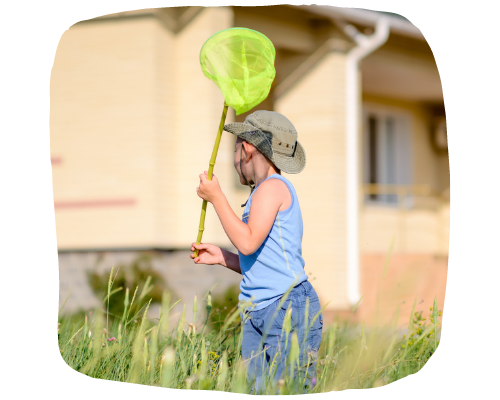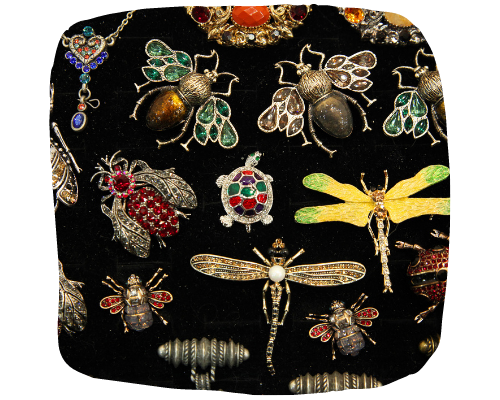Children at the youngest age tend to be naturally curious about insects. Insects are everywhere, from our backyards and balconies to parks and even in our homes.
I love the delight on children’s faces when they see a butterfly flutter by or a ladybug strolling on a plant. In my home, we are pretty amazed when it comes to God’s amazing insects.

Insects are one of the most diverse species on the earth and the largest class of animals with millions of species. Entomology is the study of insects, and it is a vast field to explore with your children. You can easily teach concepts of entomology to all ages year-round.
The study of insects is a great topic to start with children as young as preschoolers. There are several curriculums, free and paid lesson plans online about insects. You can go beyond the basics of just learning the parts of insects, insect life cycles, and insect migration. Consider exploring different insect habitats, pollinators, insects in the garden, invasive insects, camouflage, mimicry, taxonomy, or insects as food throughout the world.
Insects are appropriate for every subject of study, and rightly so with the wide range of studies you can explore.
Science
Science is the most obvious subject with insects. You can collect or even purchase insects and observe their life cycle right before your eyes. There are several kits for butterflies, ladybugs, and ant farms you can purchase. Other insects that you can do are Madagascar hissing cockroaches or praying mantis is just a few other options. This is a fun project for all ages to explore.
One of the most common science explorations is catching and observing insects. You just need a few supplies: a net, magnifying glass, notebook or sketch pad, and a clear container to observe them closer. Many of these items can be purchased at a dollar store. I recommend an insect field guide to identify the insect. Your local extension office or book stores will have field guides of insects from your state. Go outside and look on the trees, flowers, shrubs, plants, under eaves, in the soil, and under rocks to find a variety of insects at all hours of the day.

Plant a pollinator garden to attract native bees, butterflies, moths, flies, beetles, and hummingbirds. You will have a plethora of insects to observe in your garden. If you don’t have much space, you can plant in pots on a balcony or find a small space in your yard. Find native plants that grow well in your area. Many of our native bees and insects are disappearing, and growing native plants will help them out. Keep a record of the types of plants you have and what insects visit certain plants.
You can buy or build insect houses to place in your garden. Observe which insect makes a nest in your insect house. Many bees and an assortment of insects build their nest at different times of the year. Some colleges and entomologists might welcome your results if you keep good records.
Aquatic insects play a major role in the aquatic ecosystem. They help break down and decompose dead material at the bottom of lakes and rivers. The more diversity of aquatic insects you have the healthier the body of water is. You can collect, observe, and identify aquatic insects to measure water quality.
Go on a nighttime bug hunt. You can go out with a net and flashlight in search of insects. If you want to yield a lot of insects in a short time, hang a white sheet up and plug in a black light on one side of the sheet. Your sheet will quickly attract various insects throughout the night. You can identify your specimens you collect and record the results.
Physic can be taught using insects. The aerodynamics of their wings as they flap with the front going down and forward and then up and backward, making a figure-eight motion to fly with the oncoming air. I find it amazing that these small creatures can even fly. There are several areas to discover in physics with insects.

In chemistry, you can learn about pheromones that insects secrete to attract a mate. Other insects use it for defenses like a grasshopper or ladybugs.
If you have a child who shows more interest in entomology, you can teach them how to collect, pin, and preserve them. Making a collection will help you learn anatomy, identification, and classification. Many insects have painful bites and stings, so handle unknown specimens with caution. There are ways to safely catch insects without getting bit or stung. 4-H is a great way to get involved in collecting and learning about insects.
Social Studies
Human history is full of topics around insects from plagues, the silk trade, honey, religious practices, myths, agriculture damage, insects as food, and invasive insects from other countries are just a few topics.
Language Arts
Insects are found throughout poetry, literature, riddles, rhymes, and songs. There are many idioms like “busy as a bee” or “ants in your pants.” You can research how and where the idioms came into our languages.
Bible
God has a lot to say about insects. Fifty-five verses in the Bible mention insects and several that mention similar things like honey and honeycomb.
Think about the lessons you can learn from a butterfly. The butterfly can’t go back to being a caterpillar. Trusting in Jesus is pretty much the same: we become a “new creation”. There are several types of insects mentioned throughout the Word, and we can learn a lot from them.
Art

Insects have shown up in every part of the world in various forms of art. You can find them in jewelry, pottery, and cave drawings. Insects are used as pigments for paint and dyes for clothing. It might surprise you how often you find insects in art.
There are countless fun art and crafts you can create with an insect theme to enhance your insect study.
Music
God created the first musicians with their high-pitched songs coming from cicadas, crickets, grasshoppers, and other insects. If you listen carefully, you will hear chirps, buzzing, clicking, and other sounds. Finding and identifying the sounds of insects can be an amazing and delightful challenge. You can locate and download insect sounds online.
Insects are depicted in several styles of music, including classical, pop music, and some fun kid songs. A few examples are Nikolai Rimsky-Korsakov’s “Flight of the Bumblebee,” “Grasshoppers” from Kalevi Aho, and “Five Little Lady Bugs.”
Math
Math may seem far-fetched and borders on science. You can have fun with the temperature of the male cricket. His chirp frequency changes with temperature. You can easily observe this by counting the chirps when you find a cricket inside. Adjust your temperature and see what happens.
Even patterns and shapes from hexagon of a honeycomb, compound eyes, egg sacks, and other patterns you will find throughout the insects world.
We can’t forget about weight and how much insects can lift and carry. I think ants are pretty amazing watching them carry food to their nest.
You can teach basic mathematical insect themes to add some buzz to your lessons.
Entrepreneur
Honeybees are a fascinating bunch of insects and beekeeping is a fun and tasty hobby with the potential to earn a few bucks. Beekeepers are usually pretty excited about sharing about bees and may let you suit up and go into the hives. Beekeeping is a great way to teach skills some useful life skills by selling honey and other products from the hive.
If the stinging insects don’t appeal to you there are always crickets. Bait shops, fishermen, and pet stores are just a few other options.
Entomology is a fascinating study, and there are so many topics to teach year-round in your homeschool!
Special thanks to Renee K @ Little Homeschool on the Prairie for writing this Crew Article.
VISIT THE CREW BLOGS
You’ll want to make sure you visit the Homeschool Review Crew personal blogs to read more about all the topics in this month’s Crew Challenge! There’s so much encouragement to be found!

